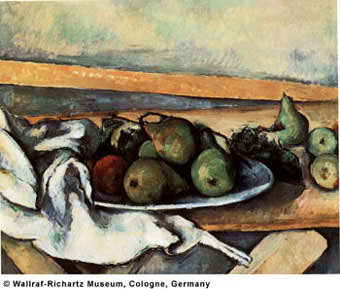
Lesson #6
Paul Cézanne (say-ZAHN)
French, 1839-1906
Still Life with Pears, about 1885
Oil on canvas
15 x 18 1/8 in.
Wallraf-Richartz Museum, Cologne, Germany
Subject
This is one of more than 170 still life paintings Paul Cézanne created in his lifetime. At first glance, it's a simple arrangement of pears on a tabletop, but a second look shows us that the objects are not true to nature. What, for example, is the gauzy black mass to the right of the plate? Is that really drapery protruding stiffly beyond the table's edge? Indeed, Cézanne liked to make ordinary objects look unfamiliar, a radical idea in the late 19th century. To him, studying nature was merely the first step in making art. After that, Cézanne explained, the artist should "make pictures that teach us something." Often that "something" was to see a scene from different points of view. Like his fellow Impressionists, Cézanne was intrigued by the optic sciences. Notice how he distorted perspective in this painting by showing the tabletop parallel to the picture frame on the right, but pulled away from the wall on the left. Is that a strip of wood slashing flat across the background?
The artist seems to have lifted the back of the table and tipped it forward. The objects on it appear to slide into our laps.
Style
Like other Impressionists, Cézanne painted with quick, visible brushstrokes, laying on colors next to each other. In this painting, the red pear appears more intensely red when placed among the green pears. Cézanne understood that when complementary colors like red and green (found on opposite sides of the color wheel) are placed adjacently in a painting, they vibrate with intensity.
Many other Impressionist painters used contrasting colors to describe the play of light on the surfaces of forms. Cézanne often used colors to articulate the forms and the composition. For instance, in this painting the arrangement of the three pears on the right and the three pears on the plate is emphasized by bits of black and contrasted with the one red pear. The odd-numbered groupings of simply shaped objects in contrasting colors are characteristic of Cézanne's still life paintings. Cézanne tried to show internal construction of the forms that he painted, "nature as cylinders, sphere, and cones," in his words.
Artist
Paul Cézanne was born to a wealthy family in the town of Aix-en-Provence. Temperamental and shy, he became an artist against his father's wishes.
Fellow artist Camille Pissarro introduced him to Impressionism in the 1870s and became a lifelong friend, encouraging Cézanne to paint from nature and providing emotional support. Still, Cézanne grew disillusioned with Impressionism, distrusted fellow artists, and refused to exhibit with the group after their second show. "I wanted to make of Impressionism something solid and enduring, like the art in museums," he once said.
Looking Questions
- What is a still life? Why would someone paint a still life?
- Does this painting seem radical to you in any way?
- Discuss Cézanne's choice of objects. Do some of them seem odd or distorted?
- Are there any colors that surprise you?
- What circular shapes do you see? What do the circular shapes represent?
- Where do you see triangles? Straight lines? Curvy lines?
- Where do you see the color yellow in the painting? Why do you think the artist chose to use yellow?
- What shapes did he choose to repeat?
- Do some of the objects have similar colors?
Activities
The Arts
First, place a sheet of clear plastic over the transparency and draw the basic geometric shapes of the still life. Cézanne said he wanted to "treat nature by the cylinder, the sphere, the cone." Set up a still life of objects with simple shapes like soft drink cans or bottles and a bowl of fruit on a cafeteria tray. Ask the students to draw from it. Challenge your students to simplify the image by drawing only three-dimensional geometric shapes.
Math or Science
Name at least three geometric solids or flat shapes represented in this composition.
How many shapes or forms appear to be touching each other? How many are overlapping? Carefully copy at least two different shapes by drawing their outlines on a piece of paper and cutting them out. See if someone else can find which ones you copied.
Language Arts
Discuss the definition of still life with your students. Then, tell them to "write a still life." Each student lists their favorite personal objects and draws their outlines. Next, the objects are cut out and glued to another piece of paper. After that, the students write descriptions of each object around the outline of the cut-out shape. This way, the students will have a written and visual description of the objects.
Social Studies
The artist Paul Cézanne has moved through a time machine to be the art teacher for the class. The students have the opportunity to ask Cézanne questions about the choices he made as an artist. What questions are they curious about? Write down a few questions after reading the information and looking at the transparency.
Continue reading on to the next page, #7: Van Gogh, Self-Portrait with a Straw Hat.
